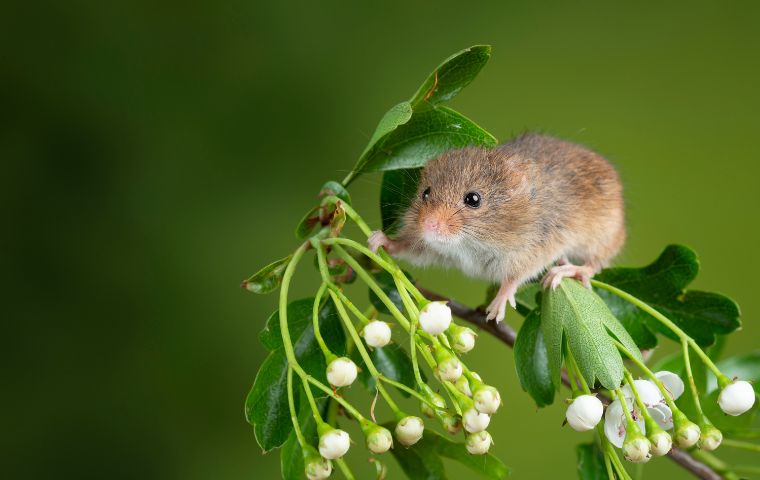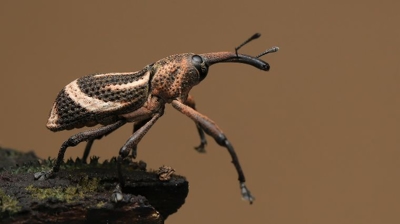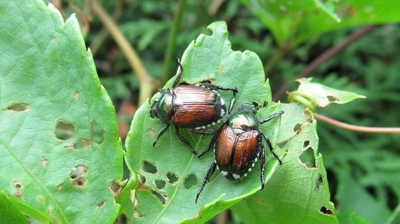
Harvest Mice
What Are Harvest Mice?
Harvest mice (Micromys minutus) are small rodents native to Europe and parts of Asia. They are the only Old World mice with prehensile tails, which help them climb and navigate through dense vegetation, especially in grasslands, reed beds, and farmland. These mice are among the smallest rodents in Europe, typically measuring around 5–7 cm (2–3 inches) in body length, with tails almost as long as their bodies.
They are well adapted to life in tall grasses, often weaving intricate spherical nests above the ground using grass and plant fibers. Their diet consists mainly of seeds, berries, insects, and small invertebrates. Harvest mice are active mainly at night and have a short lifespan of about 18 months in the wild.
Despite their small size and delicate appearance, they are excellent climbers and can move nimbly through dense vegetation. Their populations fluctuate due to habitat loss, predation, and climate conditions, but conservation efforts aim to preserve their natural habitats.
Are Harvest Mice Harmful?
Harvest mice (Micromys minutus) are generally not considered major pests or harmful animals, but in certain situations, they can pose some issues, particularly in agricultural and stored food environments. Here are a few ways they might be considered problematic:
- Crop Damage – Harvest mice can feed on grains, seeds, and fruits, potentially causing minor damage to crops such as wheat, barley, and oats. However, their small population sizes and feeding habits usually don’t lead to large-scale agricultural losses.
- Stored Food Contamination – Like other rodents, if harvest mice gain access to stored grains or food supplies, they can contaminate them with droppings, urine, and fur, posing health risks.
- Structural Damage – Though less destructive than other rodents like house mice or rats, harvest mice may chew on materials such as insulation, wires, and packaging when nesting in buildings or storage areas.
- Potential Disease Carriers – While not as significant as some larger rodent species, harvest mice can still carry parasites, bacteria, or viruses that may pose a risk to humans and livestock, especially in areas where food is processed or stored.
- Competition with Other Wildlife – In rare cases, high populations of harvest mice could compete with other small mammals or birds for food resources, though this is generally not a major concern.
Despite these potential downsides, harvest mice are often seen as beneficial in natural ecosystems, as they help control insect populations and serve as prey for birds of prey and other predators.
Harvest Mouse Appearance
Harvest mice (Micromys minutus) are small, delicate rodents with distinctive features that set them apart from other mice. Here’s what they look like:
- Size – They are tiny, typically measuring 5-7 cm (2-2.8 inches) in body length, with an additional 5-6 cm (2-2.4 inches) long tail. They usually weigh between 4-6 grams (0.14-0.21 ounces).
- Fur Color – Their fur is a warm, golden-brown on the upper body, with a white or pale gray underside.
- Tail – Their long, prehensile tail is one of their most distinguishing features. It is about the same length as their body and helps them grip and balance while climbing through tall grasses and reeds.
- Ears & Eyes – Harvest mice have small, rounded ears that are partially hidden by their fur, unlike the more prominent ears of house mice. Their eyes are small, dark, and bead-like, giving them an alert appearance.
- Nose & Whiskers – They have a short, pointed snout with long, fine whiskers that help them navigate their environment, especially in tall grasses.
- Feet & Claws – They have tiny but strong claws and feet adapted for climbing, enabling them to grasp onto stems and reeds with ease.
Harvest mice have a tiny, agile, and lightweight build, perfectly suited for their life in dense vegetation, where they can move effortlessly among grasses, reeds, and crops. Their small size and golden-brown fur help them blend into their surroundings, making them harder for predators to spot.
Harvest Mouse Habitat
Harvest mice (Micromys minutus) are most commonly found in grasslands, wetlands, reed beds, hedgerows, and farmland across Europe and parts of Asia. They prefer habitats with tall grasses or dense vegetation where they can build their distinctive woven nests above ground.
You are most likely to encounter them in:
- Marshes and reed beds – They thrive in wetlands where reeds and sedges provide food and nesting sites.
- Farmland and crop fields – They are often found in wheat, barley, and oat fields, particularly during the growing season.
- Hedgerows and meadows – Dense, grassy areas offer cover from predators and materials for nest-building.
- Grasslands and heathlands – Tall grasses provide an ideal environment for climbing and nesting.
Since harvest mice are small, elusive, and primarily nocturnal, spotting them can be challenging. The best way to detect their presence is by looking for their woven nests about 30 cm (12 inches) above the ground in dense vegetation.
Harvest Mouse Diet
Harvest mice (Micromys minutus) primarily feed on a diet of seeds, grains, and plant material. They are omnivorous and will also consume small insects, such as aphids and caterpillars, especially during the warmer months when insect availability is high. Their diet consists of:
- Seeds and Grains: They eat a variety of grass and cereal grains, such as wheat, oats, and barley.
- Fruits and Berries: They occasionally consume soft fruits like blackberries and raspberries.
- Leaves and Stems: Some plant materials, particularly tender shoots, supplement their diet.
- Insects and Small Invertebrates: They eat insects such as aphids, caterpillars, and small beetles, providing an important protein source.
- Nectar and Pollen: In some cases, they may feed on nectar or pollen from flowers.
Since harvest mice are mostly found in grasslands, reed beds, and hedgerows, their diet is closely linked to their habitat, changing seasonally based on available food sources.

Harvest Mouse Life Cycle
The life cycle of harvest mice (Micromys minutus) consists of several distinct stages, from birth to adulthood. These tiny rodents have a relatively short lifespan, usually around 18 months to 2 years in the wild, though they can live longer in captivity.
Mating & Reproduction
- Harvest mice breed primarily between May and October, though breeding may continue in mild climates. Females can produce multiple litters per year, typically three to seven litters, depending on environmental conditions. Each litter consists of 3 to 8 pups, with an average of around 5 to 6.
Gestation & Birth
- The gestation period lasts about 17 to 19 days. After this short pregnancy, the mother gives birth to hairless, blind, and helpless pups in a carefully woven nest, usually positioned in tall grasses or low shrubs about 30–100 cm above the ground.
Neonatal Stage (0–5 days)
- At birth, the pups are about 1 cm long and completely dependent on their mother for warmth and nourishment. They remain in the nest, feeding on the mother’s milk. Their fur starts to develop within a few days.
Juvenile Stage (5–10 days)
- By around 5 days old, the young harvest mice start to develop a full coat of fur. Their eyes begin to open at around 8–10 days. They still rely heavily on their mother but start to move around more.
Weaning & Independence (10–15 days)
- At about 14–16 days, the pups are fully furred, mobile, and begin to explore outside the nest. They start to eat solid food, including seeds, fruits, and insects, though they continue to nurse for a short period.
Subadult Stage (15–30 days)
- Around 20–30 days, young harvest mice become completely independent. They disperse to find their own territory and begin foraging actively. This stage is crucial for survival as they face predation from birds, reptiles, and mammals.
Sexual Maturity & Adulthood (30+ days)
- By 4 to 6 weeks of age, harvest mice reach sexual maturity and are capable of breeding. Since they have a short lifespan, they reproduce quickly to maintain population numbers.
Aging & Lifespan
- In the wild, most harvest mice live 12–18 months, though some may survive up to 2 years. High predation rates and environmental factors contribute to their relatively short lifespan.
This rapid life cycle allows harvest mice to thrive in their grassy habitats, ensuring their populations remain stable despite natural threats.

Hear From Our Happy Customers
-
"Exceeds Expectations"
I can’t say enough positive things about this company... The tech that came out, Jarvis went above and beyond my expectations. Thank you guys, I will continue using your services.
- Jake M. -
"Wonderful Service"
Wonderful service. Jarvis is great. Took care of everything I needed. Thank you!
- Henry P. -
"Very Knowledgeable"
The tech that arrived was courteous, professional, and very knowledgeable. He was Great.
- Uerial I. -
"Professional & Considerate"
I’m pleased with Miche services. Jarvis came today. Professional and considerate. Thank you!
- Judy B. -
"Fantastic & Patient"
Jarvis was fantastic and patient. He answered my questions with an in-depth explanation and addressed all of my areas of concern. Would love for him to be my assigned tech going forward. Well done!
- Yonnette M. -
"Great Communication"
Tech was on time, communication was great, and he accommodated my needs.
- Alonzo W.




